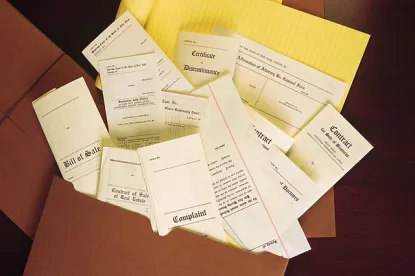The notice of appeal is the most fundamental filing in appellate practice because it is the document that transfers jurisdiction from the trial court to the reviewing court. All state and federal reviewing courts require that the notice of appeal be filed within a specific amount of time – 30 days, for example, in Illinois – and uniformly hold that a notice of appeal filed late is a nullity. While counting to 30 is simple, correctly ascertaining the event that starts the appeal clock ticking is not, as a recent decision of the Illinois Appellate Court demonstrates.
Background
In Country Mutual Ins. Co. v. Best Pallet Co., LLC, 2016 IL App (1st) 141269-U., the circuit (trial) court entered its order resolving the last remaining claims in this multi-claim case on the merits on December 6, 2013. On that same day, the circuit court also entered an order scheduling a status hearing for January 9, 2014. At the January 9, 2014, hearing, the circuit court entered an order stating that the December 6, 2013, order was “final and appealable” as of that date (January 9, 2014). The plaintiff moved to reconsider both orders and ultimately filed a notice of appeal on April 29, 2014, after the motion to reconsider was denied.
The appellate court dismissed the appeal for lack of jurisdiction on the ground that the plaintiff filed the notice of appeal too late, concluding that the plaintiff was required to file the notice of appeal within 30 days of the December 6, 2013, order. The appellate court reasoned that the December 6, 2013, order was the final judgment in the case because it resolved all remaining claims in the case on the merits.
The plaintiff raised four arguments to the contrary, all of which were rejected:
-
Plaintiff’s argument: The December 6, 2013, order was not the final judgment because when the order was entered, the plaintiff’s motion to compel discovery was still pending. The appellate court’s response: “Here, plaintiff’s motion to compel did not survive the circuit court’s December 6, 2013, order, but was effectively mooted by it…. When a circuit court issues a final judgment adjudicating the merits of the parties’ claims, however, ancillary issues not yet ruled upon become moot…. Because the discovery sought was only relevant to an issue already decided on the merits, the motion to compel became moot.”
-
Plaintiff’s argument: The December 6, 2013, order was not final because the trial court set a future status hearing date. The appellate court’s response: “It is true that a judgment is not considered final and appealable where the court reserves an issue for further consideration or otherwise manifests an intention to retain jurisdiction for the entry of a further order [on the merits]…. However, there is no indication in the record that the hearing set for January 9, 2014, was not scheduled to insure [sic] compliance with the court’s orders rather than to decide some additional issue on the merits.”
-
Plaintiff’s argument: The plaintiff and the defendants “did not believe that all matters had been resolved on December 6, 2013.” The appellate court’s response: “We are aware of no authority … standing for the proposition that what the parties subjectively believe or intend can affect a circuit court’s jurisdiction. Indeed, given that a lack of subject matter jurisdiction cannot be cured through consent of the parties, it hardly stands to reason that it could be cured through their mutual mistake.”
-
Plaintiff’s argument: The January 9, 2014, order stated that the December 6, 2013, order was final and appealable as of January 9, 2014. The appellate court’s response: “The circuit court’s January 9, 2014, order … essentially attempts to restart the clock on the 30-day deadline imposed by Rule 303 [for filing a notice of appeal]…. We are aware of no authority empowering a court to avoid the consequences of a prior final judgment in this manner. The circuit court lost jurisdiction over this matter 30 days after it resolved the last of the parties’ claims on the merits, or on January 6, 2014. The order it issued three days later on January 9, 2014, was therefore void.”
Appellate Court Order
“In sum,” the appellate court concluded, “plaintiff has advanced no convincing argument in support of this court’s jurisdiction over this matter. Plaintiff’s notice of appeal was not filed within 30 days of the circuit court’s December 6, 2013, order disposing of all the parties’ claims; no timely post-judgment motion was filed; and no extension of time was granted before the circuit court lost jurisdiction. We must therefore dismiss this appeal for lack of jurisdiction…. We understand that it may have caused the parties some confusion when the circuit court issued a written order disposing of the last of their substantive claims and then, by separate order entered the same day, scheduled a future status hearing for an unspecified purpose…. Whatever the case, we are bound by the rules that narrowly circumscribe this court’s jurisdiction. Where litigation involves multiple claims, the obligation ultimately lies with the parties to track the circuit court’s disposition of the substantive issues raised in the pleadings, to act promptly in accordance with the rules to preserve arguments for appeal, and to seek clarification from the court when the effect of its orders is in doubt.”
Pointer
As the Illinois Appellate Court observed 16 years ago, “For the trial advocate, appellate jurisdiction is akin to strolling through a minefield.” Physicians Insurance Exchange v. Jennings, 316 Ill. App. 3d 443, 446 (1st Dist. 2000). Country Mutual Insurance demonstrates that this “minefield” is best traveled by dedicated appellate practitioners. The notice of appeal is the only document that vests the appellate court with jurisdiction over a case, and if it is filed late, the right to appellate review is lost and the case is over.


 />i
/>i
